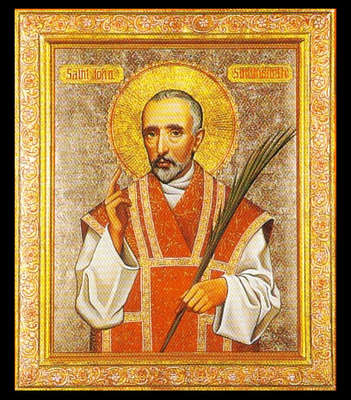- Jun 9, 2010
- 11,093
- 6,889
- Country
- United Kingdom
- Faith
- Catholic
- Marital Status
- Single
- Politics
- UK - SNP
St John Southworth
Celebrated on June 27th

Saint John Southworth came from a Lancashire family, the principal members of which seemed to have lived at Samlesbury Hall.

image.jpg4924×1692 2.94 MB
He is thought to have been born in 1592 and was martyred at Tyburn on 28 June 1654.
In 1618, John Southworth was ordained a priest at the English College, Douai (Douay) in Northern France. After returning to England, he was arrested and condemned to death in Lancashire in 1626, and imprisoned first in Lancaster Castle, and afterwards in the Clink Prison, London. On 11 April, 1630, he and some other priests were delivered to the French Ambassador for transportation abroad, but, in 1636, he was reported to have been released from the Gatehouse, Westminster, and was living at Clerkenwell. From there it seems he frequently visited the plague-stricken dwellings of Westminster to administer the sacraments and comfort the sick and the dying. In 1637, he appears to have been based in Westminster, where he was arrested on 28 November, before being again sent to the Gatehouse. From there he was transferred to the Clink and, in 1640, was brought before the Commissioners for Causes Ecclesiastical, who sent him back there.
On 16 July, John Southworth was again freed, but by 2 December he was once more imprisoned in the Gatehouse. After his final apprehension on 19 June 1654, he was tried at the Old Bailey, where he insisted on pleading guilty to being a priest. He was reluctantly condemned to be hung, drawn and quartered. On the day of his martyrdom, he was allowed to make a long speech at the gallows.
The Spanish ambassador bought his body from the executioner and, in 1655, returned it to Douai after the corpse had been sewn together and embalmed. In 1656 the recovery of Francis Howard, fifth son of the Earl of Arundel, was attributed to St John Southworth’s relics. When England and France went to war in 1793 St John Southworth’s body was buried in an unmarked grave below the college for its protection. The grave was discovered in 1927 and his remains were returned to England. In 1930, his major relics - the only complete body of a Reformation martyr - were brought to Westminster Cathedral, where a shrine was prepared for them.

image.jpg1024×576 300 KB
He was beatified in 1929 and was canonised in 1970 by Pope Paul VI, as one of the Forty Martyrs of England and Wales.
Celebrated on June 27th

Saint John Southworth came from a Lancashire family, the principal members of which seemed to have lived at Samlesbury Hall.

image.jpg4924×1692 2.94 MB
He is thought to have been born in 1592 and was martyred at Tyburn on 28 June 1654.
In 1618, John Southworth was ordained a priest at the English College, Douai (Douay) in Northern France. After returning to England, he was arrested and condemned to death in Lancashire in 1626, and imprisoned first in Lancaster Castle, and afterwards in the Clink Prison, London. On 11 April, 1630, he and some other priests were delivered to the French Ambassador for transportation abroad, but, in 1636, he was reported to have been released from the Gatehouse, Westminster, and was living at Clerkenwell. From there it seems he frequently visited the plague-stricken dwellings of Westminster to administer the sacraments and comfort the sick and the dying. In 1637, he appears to have been based in Westminster, where he was arrested on 28 November, before being again sent to the Gatehouse. From there he was transferred to the Clink and, in 1640, was brought before the Commissioners for Causes Ecclesiastical, who sent him back there.
On 16 July, John Southworth was again freed, but by 2 December he was once more imprisoned in the Gatehouse. After his final apprehension on 19 June 1654, he was tried at the Old Bailey, where he insisted on pleading guilty to being a priest. He was reluctantly condemned to be hung, drawn and quartered. On the day of his martyrdom, he was allowed to make a long speech at the gallows.
The Spanish ambassador bought his body from the executioner and, in 1655, returned it to Douai after the corpse had been sewn together and embalmed. In 1656 the recovery of Francis Howard, fifth son of the Earl of Arundel, was attributed to St John Southworth’s relics. When England and France went to war in 1793 St John Southworth’s body was buried in an unmarked grave below the college for its protection. The grave was discovered in 1927 and his remains were returned to England. In 1930, his major relics - the only complete body of a Reformation martyr - were brought to Westminster Cathedral, where a shrine was prepared for them.

image.jpg1024×576 300 KB
He was beatified in 1929 and was canonised in 1970 by Pope Paul VI, as one of the Forty Martyrs of England and Wales.
